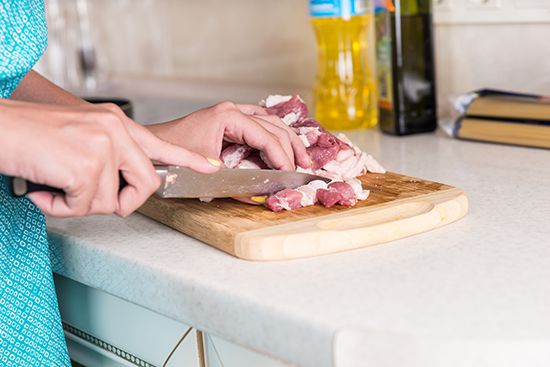
A quick refresher on cooking safety tips never hurts! Whether you’re a beginner or a seasoned cook, these safety tips in the kitchen should always be followed to guarantee a great meal. Remember: keep it clean, don’t cross-contaminate, and be sure to follow these other tips for food safety.
Avoid Cross-Contamination
Close up Woman Slicing Fresh Pork Into Small Pieces on Top of a Wooden Chopping Board In the Kitchen.
One of the best ways to ensure food safety is to avoid cross-contamination. Be sure to follow these food safety and sanitation tips:
- Use a plastic cutting board to cut up raw poultry, meat, or fish. Wash the board with hot, soapy water after every use and before using it with another type of food. If possible, purchase two different cutting boards. Use one only for raw meats, poultry, fish, and shellfish, and the other for ready-to-eat foods such as bread and vegetables.
- Never put cooked poultry, fish, or meat on the same board or in the same container that held the raw meat, unless you have washed the container well first.
- Don’t wash raw beef, pork, lamb, poultry, or veal before cooking. Rinsing these foods poses a risk of cross-contamination with other foods and utensils. Bacteria that might be present are destroyed with proper cooking.
- Place cooked foods on a clean plate. Never reuse the unwashed dish that held the raw meat, poultry, fish, or shellfish.
- Store raw meat, poultry, fish, and shellfish in sealed containers or plastic bags so the juices don’t drip onto other foods.
Keep it Clean
Wash, wash, wash your hands! A huge part of food hygiene information is keeping yourself (and your kitchen) squeaky-clean:
- Before cooking anything, thoroughly wash your hands with warm, soapy water.
- Keep your surfaces and utensils clean. When in doubt, it never hurts to give your counter an extra scrub. Use hot, soapy water to clean any surface that comes into contact with raw meat or chicken.
- Wash fresh fruits and vegetables with water only (no soap) before eating or preparing them.
When in Doubt, Throw it Out
One of our most important food safety guidelines? When in doubt, throw it out:
- If food hasn’t been properly handled or stored, even cooking it correctly won’t make it safe. If you aren’t sure that food has been prepared, served, or stored safely, throw it away.
- Never tasted food to see if it’s safe—contaminated food can taste, smell, and look good enough to eat. But even eating a small amount can make you sick.
- If there are visible signs of mold or spoilage, do not attempt to remove it or save parts of the dish. Throw the entire thing away.
How to Thaw Safely
Believe it or not, there is a right way to thaw foods. Follow these safety tips in the kitchen to ensure you thaw foods properly:
- Thaw foods in the fridge, never at room temperature. A few exceptions include breads and sweets that specifically call for thawing at room temperature. Make sure thawing foods don’t drip onto other foods in your fridge.
- Some foods can be successfully thawed in a microwave. Follow the manufacturer’s instructions and cook food immediately after thawing.
- You can also thaw by placing food in a leak-proof plastic bag and immersing it in cold tap water in the sink (do not use warm or hot water), changing the water every half hour to keep it cold. When changing the water, flip the bag if it’s not fully submerged. Cook food immediately after thawing.
Two-Hour Time Limit
We all love leftovers, but be sure to follow food safety guidelines to store them properly. To make sure your leftovers bacteria-free, refrigerate them immediately after the meal is finished. Discard any food that has been left out for more than 2 hours (or 1 hour if the air temperature is higher than 80 degrees F).
Tips for Safe Serving and Toting
Food safety and sanitation doesn’t stop in the kitchen. Follow these guidelines for serving and toting your culinary masterpieces:
- When toting hot foods, use heavy-duty foil, layers of newspaper, or a heavy towel to wrap the container well. Place the wrapped container in an insulated container to keep the food at or above 140 degrees F.
- If you’re serving hot foods buffet-style, use chafing dishes, slow cookers, and warming trays to keep food above 140 degrees F.
- Buy cold, perishable foods last when shopping. Go straight home and refrigerate them immediately.
- When serving cold foods buffet-style, place the foods on a tray over ice. Discard after 2 hours (or 1 hour if the air temperature is over 80 degrees F).
- When toting cold perishable foods, keep them at 40 degrees F or lower by packing them in a well-insulated cooler with plenty of ice. A full cooler will maintain its cold temperature longer than a partially filled one.
Food Safety Practices to Keep in Mind
Before you get back to cooking, take one last look at this food safety information:
- Keep hot foods hot. Raw eggs, meat, fish, and poultry must be cooked well to kill harmful bacteria.
- Keep cold foods cold. Foods that are meant to be kept refrigerated should be cold when you touch them. Foods that are meant to be kept frozen should be extremely cold and hard as a rock.
- Don’t use cracked or dirty eggs—they may have been contaminated with harmful bacteria. Be sure to wash your hands, the equipment, and the countertop after working with raw eggs. Avoid eating raw eggs. There’s no need to wash your eggs though and here’s why!
- Always use fresh foods!
